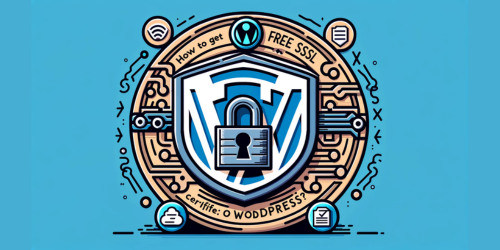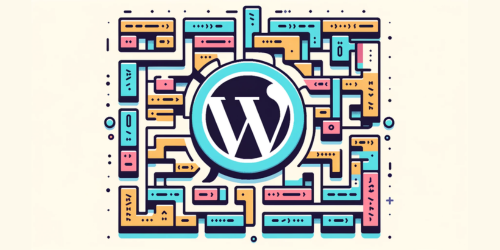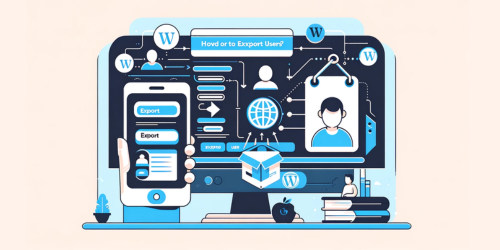Have you ever paused to consider the engine that powers nearly 40% of the web? That’s right, we’re talking about WordPress. This platform, which began as a humble blogging tool, has metamorphosed into a digital juggernaut, driving everything from personal blogs to enterprise-level websites. Its omnipresence in the digital realm is undeniable.
Yet, for many, the intricacies of WordPress remain shrouded in mystery. Who Owns WordPress? How is it structured? And why do permissions matter? These aren’t just questions for the tech-savvy or the curious. They’re fundamental for anyone keen on harnessing the full power of this platform. As we journey through this article, we’ll unravel these layers, offering you a clear lens through which to view the world of WordPress.
1. The Genesis of WordPress
In the annals of digital history, 2003 stands out as a watershed year. It was then that two visionaries, Matt Mullenweg and Mike Little, unveiled the first version of WordPress. What started as a simple fork from an existing tool called b2/cafelog, rapidly transformed into a beacon for content creators worldwide. The allure? A platform that was both user-friendly and robust, catering not just to businesses but to individual bloggers and writers yearning for a digital canvas.
Fast forward to today, and WordPress stands tall as a dual entity, often leading to some confusion. On one hand, there’s WordPress.org, the open-source platform that’s free for all. It’s the heart and soul of the WordPress community, a place where users can download, modify, and self-host their websites. On the other hand, there’s WordPress.com, a commercial venture that offers hosting services, themes, and plugins. It’s a one-stop-shop for those who prefer a more managed experience.
This bifurcation, while initially perplexing, underscores WordPress’s commitment to versatility. Whether you’re a DIY enthusiast or someone seeking a streamlined solution, WordPress has a home for you.
2. The Titans Behind Who Owns WordPress?
When we talk about WordPress, it’s impossible to sidestep the colossal influence of one entity: Automattic. Founded by the visionary Matt Mullenweg, Automattic is the commercial force behind many of WordPress’s most popular features and services. Mullenweg, with his keen foresight, not only pioneered the open-source movement with WordPress.org but also recognized the potential for a more streamlined, commercial platform, leading to the birth of WordPress.com.
But Automattic’s prowess doesn’t end with WordPress. They’ve cast a wide net across the digital realm, acquiring and developing a suite of products that complement their flagship offering. Take Tumblr, for instance, a microblogging platform that, under Automattic’s wing, has flourished and found its unique space in the blogging ecosystem. Then there’s WooCommerce, a customizable, open-source eCommerce platform built on WordPress, and Jetpack, a plugin designed to optimize WordPress site performance and security.
Financially, Automattic’s trajectory has been nothing short of meteoric. From a valuation of $1.2 billion in 2014, the company’s worth skyrocketed to an impressive $3 billion by 2019, a testament to its innovative products and the unwavering trust of its user base.
In the grand tapestry of the digital world, Automattic, with Mullenweg at its helm, stands as a testament to what vision, innovation, and commitment to user experience can achieve.
3. Understanding WordPress Permissions
Imagine walking into a library where every book is locked in a glass case. Frustrating, right? In the digital realm, incorrect permissions can create a similar barrier, hindering the smooth operation of a website. For a platform as intricate as WordPress, ensuring the right permissions is paramount.
I. Why Permissions Matter?
At its core, WordPress is a collection of files and folders. Each of these has specific permissions, determining who can read, write, or execute them. When these permissions are set correctly, your website hums along, with plugins updating seamlessly, media uploading without a hitch, and themes installing effortlessly. However, if permissions are too restrictive, certain WordPress features might hit a wall. Conversely, overly permissive settings can pose security risks, potentially opening doors to malicious attacks.
II. File vs. Folder Permissions
While both files and folders in WordPress require permissions, there’s a distinction in their optimal settings. Typically, files should have a permission setting of 644, meaning the owner can read and write, while everyone else can only read. Folders, being containers that can hold files, have a slightly different setting. They usually come with a permission of 755, allowing the owner to read, write, and execute, while others can only read and execute.
III. Correcting Missteps
If you’ve discovered incorrect permissions, don’t panic. Tools like FileZilla or direct server access allow administrators to adjust permissions. For those using hosting platforms with cPanel, the file manager provides a user-friendly interface to make these changes. Remember, though, always to backup your site before making any adjustments. This safety net ensures that, should anything go awry, you can restore your site to its previous state.
In essence, think of permissions as the gatekeepers of your WordPress site. When set correctly, they ensure both functionality and security, allowing your website to reach its full potential.
4. Monetizing WordPress: The Automattic Way
In the vast landscape of the internet, WordPress stands as a beacon for content creators, developers, and businesses. But behind its open-source ethos lies a meticulously crafted monetization strategy, championed by its parent company, Automattic. How does a platform, rooted in community contributions, strike a balance between free offerings and commercial success? Let’s delve into Automattic’s monetization playbook.
I. Diverse Revenue Streams
- Hosting: One of Automattic’s primary revenue drivers is its hosting service, WordPress.com. Catering to a range of users, from individual bloggers to large enterprises, this platform offers tiered hosting plans, each with its set of features and price points.
- Themes: While WordPress offers numerous free themes, Automattic capitalizes on the demand for premium, feature-rich themes. These professionally designed themes cater to specific niches and come with dedicated support, making them a lucrative offering.
- Plugins: Plugins enhance WordPress functionality, and while many are free, there’s a thriving market for premium plugins. Automattic’s products, like Akismet and Jetpack, serve as prime examples of how advanced features can command a price.
- Advertisements: For many bloggers on WordPress.com, ads provide a steady income stream. Automattic’s WordAds program allows site owners to display ads and share in the revenue, creating a win-win for both parties.
II. Striking a Delicate Balance
Automattic’s genius lies in its ability to harmonize its commercial endeavors with its commitment to the open-source community. While it monetizes certain aspects of WordPress, it continually invests in the platform’s development, ensuring it remains cutting-edge and accessible. This symbiotic relationship has fostered trust. Users appreciate the value of premium offerings, understanding that their financial contributions support the broader WordPress ecosystem.
In conclusion, Automattic’s approach to monetizing WordPress is a masterclass in balancing business acumen with community spirit, ensuring the platform’s longevity and relevance in an ever-evolving digital world.
5. The Community and WordPress
In the annals of digital success stories, WordPress stands out, not just for its technical prowess but for the vibrant community that propels it forward. This isn’t just a platform; it’s a movement, a collective endeavor that has redefined the way we perceive content management systems.
I. A Collective Push Towards Excellence
The heart of WordPress beats in sync with its community. From developers and designers to bloggers and businesses, every stakeholder plays a pivotal role. They contribute themes, develop plugins, offer support, write tutorials, and even organize WordCamps – global, community-organized events. This collective intelligence and shared enthusiasm have been instrumental in refining the platform, ensuring it remains responsive to the ever-evolving needs of its vast user base.
II. Open-Source: The Pillar of Popularity
At its core, WordPress’s meteoric rise can be attributed to its open-source ethos. This philosophy, which promotes collaboration and transparency, has democratized web development. No longer is creating a website the domain of the tech elite. With WordPress, anyone, irrespective of their technical know-how, can craft their digital presence. This accessibility, combined with the freedom to modify and distribute the software, has resonated deeply, fostering a sense of ownership and pride among its users.
In essence, WordPress isn’t just a product; it’s a testament to the power of community-driven innovation. It underscores the idea that when diverse minds come together, united by a shared vision, they can craft solutions that stand the test of time, transcending boundaries and redefining norms. For More insights delve into Why WordPress is open-source?
6. WordPress Security and Best Practices
In the digital realm, where threats lurk in every corner, ensuring the security of your website is paramount. WordPress, being the behemoth it is, often finds itself in the crosshairs of malicious entities. However, with the right practices and a keen understanding of its structure, you can fortify your WordPress fortress.
I. Guarding the Gates: File Ownership and Permissions
Every file and folder in your WordPress installation comes with specific permissions, dictating who can read, write, or execute them. Setting these permissions correctly isn’t just a matter of functionality; it’s a crucial security measure. Incorrect permissions can inadvertently leave doors open for hackers, allowing them to inject malicious code or compromise your site’s data. Ensuring that files are typically set to 644 and folders to 755 is a foundational step. Moreover, ensuring the right file ownership, typically aligning with the account used to run the web server, further tightens the security noose.
II. Fortifying Your WordPress Bastion
Beyond permissions, several best practices can elevate your site’s security:
- Regular Updates: Keeping your WordPress core, themes, and plugins updated ensures you’re protected against known vulnerabilities.
- Strong Credentials: Using robust, unique passwords and changing them periodically can thwart brute force attacks.
- Backup Regularly: Having a recent backup means, should the worst happen, you can restore your site to its former glory.
- Security Plugins: Tools like Wordfence or Sucuri Security offer comprehensive security solutions, from firewall protection to malware scanning.
In conclusion, while WordPress’s popularity makes it a frequent target, a proactive approach to security, rooted in best practices, can keep threats at bay, ensuring your site remains safe and sound.
7. The Future of WordPress
As we stand on the cusp of a new digital era, the trajectory of WordPress prompts both curiosity and anticipation. A platform that has consistently evolved, it’s poised to embrace the future with open arms. But what might this future entail?
I. Predictive Pathways
- Gutenberg and Beyond: The introduction of the Gutenberg block editor was just the beginning. We can expect WordPress to further refine this experience, making content creation even more intuitive and flexible.
- Headless WordPress: With the rise of JavaScript frameworks like React and Vue.js, there’s a growing trend towards using WordPress as a headless CMS. This decoupled approach allows developers to harness the content management power of WordPress while using modern technologies for the frontend.
- E-commerce Evolution: With online shopping becoming ubiquitous, platforms like WooCommerce will likely undergo significant enhancements, integrating AI, AR, and other emerging technologies to enrich the shopping experience.
II. Implications for the Ecosystem
For users, these advancements promise more power, flexibility, and ease-of-use, ensuring that WordPress remains their go-to platform for digital expression. Developers, on the other hand, will find a playground enriched with new technologies and possibilities, challenging them to innovate and create.
In essence, the future of WordPress is not just about its own evolution but about driving the evolution of the web at large, setting benchmarks, and redefining digital excellence.
8. Conclusion
Navigating the vast expanse of the digital universe, WordPress emerges as a beacon, illuminating the path for millions of content creators, developers, and businesses. But to truly harness its power, one must venture beyond the surface, diving deep into its structure, understanding its ownership dynamics, and grasping the nuances of permissions. These elements, though seemingly technical, form the bedrock upon which the WordPress empire stands.
The journey we’ve undertaken in this article is akin to peeling back the layers of an onion. From its humble beginnings to its current stature, from the titans steering its course to the community that fuels its growth, every facet of WordPress tells a story. A story of innovation, of community spirit, and of an unwavering commitment to democratizing the web.
As we stand at the crossroads of the present and the future, it’s imperative to remain curious, to stay informed, and to engage actively with WordPress. The platform, in its ever-evolving glory, promises new horizons, challenges, and opportunities. And as it charts its future course, being an informed and active participant in its journey will ensure that you, too, ride the wave of its success. So, stay curious, stay engaged, and watch as WordPress continues to redefine the digital landscape.
9. Additional Resources
For those keen on diving deeper into the world of WordPress and unraveling more of its intricacies, we’ve curated a list of resources from our very own WPPedia.net. These articles offer a wealth of information, providing insights that complement and expand upon the topics discussed in this post.
- Who is the owner of WordPress?: Delve into the history and the brains behind the world’s most popular content management system. This article sheds light on the ownership dynamics and the visionaries who brought WordPress to life.
- Automattic: Get an in-depth look at Automattic, the company that plays a pivotal role in the WordPress ecosystem. From its inception to its current ventures, this piece offers a comprehensive overview.
- Where is WordPress Headquarters?: Ever wondered where the magic happens? This article takes you on a virtual tour of WordPress’s headquarters, offering insights into its location and significance.
- The WordPress Foundation: Discover the ethos and mission of The WordPress Foundation, an entity committed to ensuring the platform’s open-source nature and its accessibility to all.
- WordPress Founder Net Worth: Curious about the financial success of WordPress’s founder? This article delves into the net worth of Matt Mullenweg, offering insights into his journey and achievements.
We encourage readers to explore these resources, deepening their understanding and appreciation of WordPress and its vibrant community.



